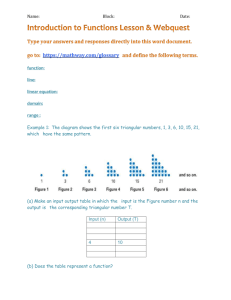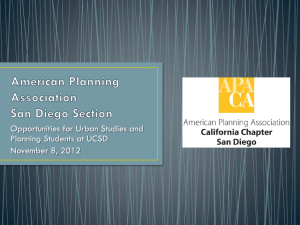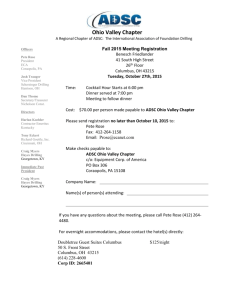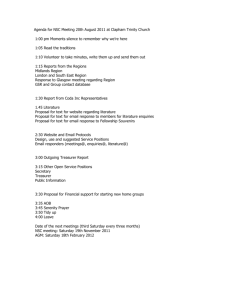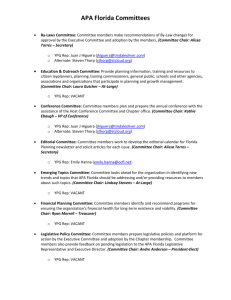• Ii~ ......,.,
advertisement
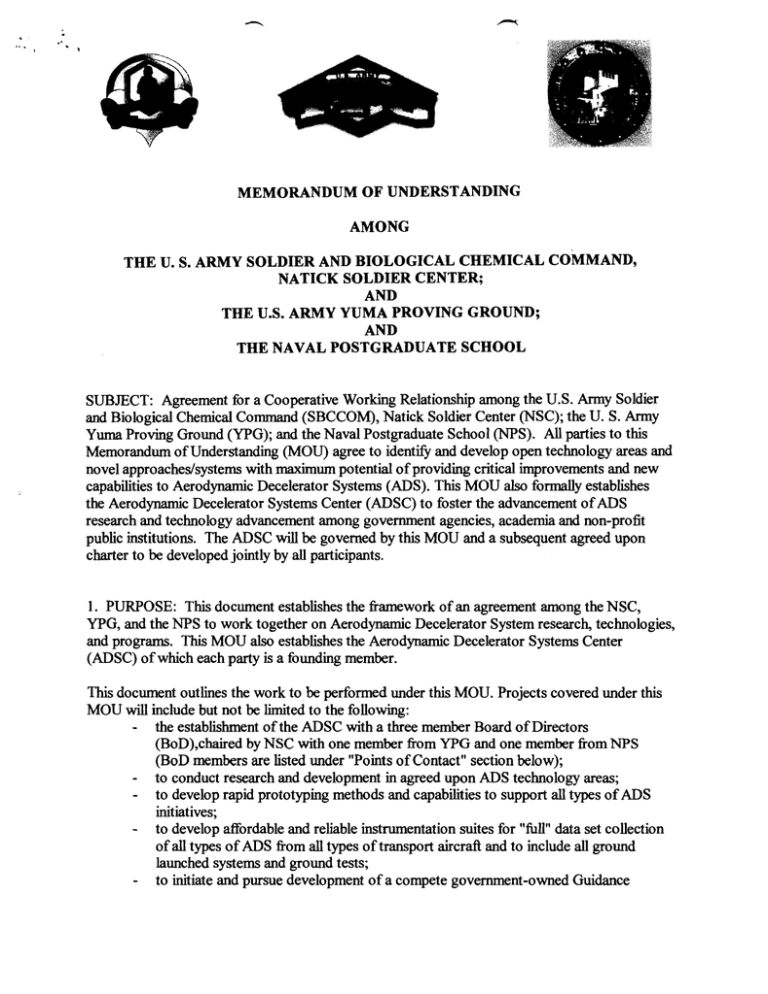
Ii~ • ......,., p~;r MEMORANDUM OF UNDERSTANDING AMONG THE U. S. ARMY SOLDIER AND BIOLOGICAL CHEMICAL COMMAND, NATICK SOLDIER CENTER; AND THE U.S. ARMY YUMA PROVING GROUND; AND THE NAVAL POSTGRADUATE SCHOOL SUBJECT: Agreement for a Cooperative Working Relationship among the U.S. Army Soldier and Biological Chemical Command (SBCCOM), Natick Soldier Center (NSC); the U. S. Army Yuma Proving Ground (YPG); and the Naval Postgraduate School (NPS). All parties to this Memorandum of Understanding (MOU) agree to identify and develop open technology areas and novel approaches/systems with maximum potential of providing critical improvements and new capabilities to Aerodynamic Decelerator Systems (ADS). This MOU also formally establishes the Aerodynamic Decelerator Systems Center (ADSC) to foster the advancement ofADS research and technology advancement among government agencies, academia and non-profit public institutions. The ADSC will be governed by this MOU and a subsequent agreed upon charter to be developed jointly by all participants. 1. PURPOSE: This document establishes the framework of an agreement among the NSC, YPG, and the NPS to work together on Aerodynamic Decelerator System research, technologies, and programs. This MOU also establishes the Aerodynamic Decelerator Systems Center (ADSC) of which each party is a founding member. This document outlines the work to be performed under this MOU. Projects covered under this MOU will include but not be limited to the following: the establishment ofthe ADSC with a three member Board of Directors (BoD),chaired by NSC with one member from YPG and one member from NPS (BoD members are listed under "Points of Contact" section below); to conduct research and development in agreed upon ADS technology areas; to develop rapid prototyping methods and capabilities to support all types of ADS initiatives; to develop affordable and reliable instrumentation suites for "full" data set collection of all types of ADS from all types of transport aircraft and to include all ground launched systems and ground tests; to initiate and pursue development of a compete government-owned Guidance Memorandum ofDnderstanding NSC / YPG / NPS Navigation, & Control (GN&C) suite with accompanying mission planning (software & hardware) for high-glide and powered payload delivery systems and to support these systems throughout its life cycle. This MOD will also formally engage all members to actively promote additional government, academic and non-profit industry partnering in critical and emerging ADS technology areas while searching for external resources and customers to support and expand ADSC initiatives. The ADSC will also seek partners to the ADSC that will be accepted by and directed by the BoD (rules to be established and called out in the ADSC charter which will be established within six months of the signing of this MOD). Implementation ofthis MOD does not guarantee any specific funding levels for any organization. External funding breakouts will be agreed upon by the BoD. Funding of ADSC initiatives can be from any partner to this MOD to any other partner within this MOD. 2. BACKGROUND: All parties to this MOD have been collaborating on a number of ADS projects including the Affordable Guided Airdrop System (AGAS) and a personnel airdrop instrumentation package. This MOD formalizes this relationship, seeks to expand the projects undertaken by all parties through the establishment ofthe ADSC and seeks to bring in both additional resources and partners to the ADSC as agreed to by the three primary partners. a) The NSC has the DoD missions for personnel, cargo and precision airdrop systems research and technology development. Therefore, NSC will chair the ADSC BoD and assure that all ADS requirements, current programs, and future programs are fully understood by ADSC members. NSC has made significant investments in precision airdrop system development and airdrop instrumentation within primarily Science and Technology (S&T) projects. NSC is also considering investments in numerous additional advanced aerodynamic decelerator systems to include autonomous (precision) and ballistic systems in all payload weight ranges. NSC is recognized as the leading experts in the area of personnel, cargo and precision airdrop systems and applications throughout DoD and, through the ADSC, plans to expand advancement in the areas of mission planning, GN&C, and airdrop instrumentation with the partners under this MOD. NSC also has a rapid prototyping capability for parachute systems, parachute components, and other airdrop system hardware. b) YPG is the D. S. Army developmental test agency for airdrop systems. NSC teams with YPG on the vast majority of S&T and developmental airdrop tests. A separate MOD is being drafted to expand on the NSC and YPG partnership regarding airdrop tests and other collaborations. YPG has extensive experience in testing airdrop systems to include airdrop rigging, airdrop instrumentation, video coverage, load tracking, and data collection systems. In addition, YPG maintains a comprehensive systems analysis capability. Resources ofthe Proving Ground have been successfully applied to the development of systems and systems improvements including the development of GN & C systems. In cooperation with NPS, 2 .' Memorandum of Understanding NSC/YPG/NPS YPG supports the rapid prototyping ofGN&C systems and the development ofGN&C computer hardware. c) NPS has extensive expertise in advanced mission planning and GN&C algorithm development and rapid prototyping of GN&C capabilities. NPS is actively involved in the AGAS GN&C development and hardware in the loop testing. System parametric modeling efforts are underway for the Affordable Guided Airdrop System. In additio~ linear and nonlinear parameter identification tools are being investigated. NPS has extensive instrumentation experience and is developing a personnel airdrop instrumentation package with YPG. 3. AUTHORITY: Authority to enter into this agreement is pursuant to authority contained in DoD Instruction 4000.19, ''1nterservice and Intragovemmental Support", August 9, 1985. 4. JOINT OBJECTIVES: It is agreed that NSC, YPG and NPS will work together to define and execute specific research and/or development projects within the ADSC (which is established under this MOU) of mutual interest through a collaborative partnership. This cooperative venture will be coordinated through the Board of Directors and will focus on technologies, concepts and products related to NSC's airdrop missions, YPG's airdrop test missions and NPS's academic programs. Specific focus areas will be advanced mission planning, GN&C (software and hardware with an emphasis on affordability, simplicity, accuracy and commonality between systems), airdrop instrumentation suites (software and hardware with an emphasis on affordability, reliability, reusability, commonality of suite for all types of airdrop loads, etc.), and exploration ofadvanced ADS technologies agreed on by all parties to this MOU. 5. RESPONSIBILITIES IN ACHIEVING THE OBJECTIVES. The parties to this MOU intend to support the joint objectives through the following efforts: All parties will maintain an active participant on the ADSC Board of Directors (BoD). Meetings of the BoD will be held as needed (with at least one formal face to face meeting per year at rotating locations) to prioritize projects, update all members ADSC activities, and to coordinate all ADSC activities. BoD meetings will be open to all members ofNSC, YPG and NPS but may have closed door sessions to prioritize and assign projects to members of each organization. NSC, YPG and NPS will support academic enhancement and advanced ADS training programs, such as workshops, seminars, special courses & special projects, as needed. 3 Memorandum of Understanding NSC / YPG / NPS Quick return technical projects will be selected to enhance the overall theoretical academic experience while also contributing to the objectives ofNSC airdrop missions. - NPS will offer ADSC projects to qualified students on a project-by-project basis with special agreed upon considerations given to security of ADSC products and agreed upon dissemination of ADSC products; All parties will allow access to the use of each others facilities and equipment (when agreed to by the BoD), outlined and agreed upon on a case-by-case basis at each organizations primary location and or other locations. NSC will provide access to YPG and NPS participants to airdrop program reviews as deemed appropriate by all parties. All parties agree to maintain continuous dialog and work towards accurate forecast scheduling and the meeting of all BoD agreed upon milestones. All parties agree to partner with other government agencies, academic partners and non-profit industry partners whom are made partners to the ADSC. The BoD will have the authority to include or not-include any proposed new partner. All potential accepted new partners will be subject to potential restricted access to the full spectrum ofADSC activities. YPG will be the primary test agency for all airdrop related projects under this MOU. YPG will be involved in all research activities under this MOU, and will maintain a password protected database of ADSC activities, documents, and products developed under this MOU. NSC will participate in all research activities conducted under this MOU, prioritize these activities (with ADSC BoD approval) and ensure that all participants are informed on known relevant research and development programs not falling under the ADSC. All participants to this MOU will assure that material (software/hardware/system performance, etc) will be protected and not provided to any third party without the written permission of all parties. All participants will also share information, software and resources to assure that ADSC products are developed rapidly, cost effectively and will minimize duplication of effort. 6. PRODUCTS: Products ofthe ADSC will include but not be limited to the following: 4 Memorandum of Understanding NSC / YPG / NPS - Developed, tested, and validated GN&C and instrumentation suites (software and hardware) for ADS prototypes. Potential Invention Disclosures (Patents) A developed and integrated process for the design and implementation of a complete ADS GNC package. Technical papers, reports, journal, conference and theses publications Documented GN&C source code (applicable to a wide range ofprecision ADS's) Documented flight and hardware in the loop test results New ADS algorithms and advanced concepts Organization and hosting of conferences, workshops, seminars and potentially short courses on relevant ADS technologies with proceedings White papers and state-of-the-art papers/articles Additional formalized partnerships within the ADSC (under consideration are: Rice University, Saint Louis University, Purdue University, Draper Laboratory, USAF (AFIT or other designated organization), others as agreed to by the BoD). 6. POINTS OF CONTACT: FORNSC Technical POC and Chair. ADSC BoD: Richard J. Benney U. S. Army SBCCOM Natick Soldier Center Team Leader, Airdrop Technology Team Kansas Street Natick, MA 01760-5017 Email: Richard.benney@natick.army.mil Phone: (508)-233-5835 Fax: (508)-233-5000 FOR YPG Technical: Scott Dellicker U.S. Army Yuma Proving Ground Division Chief Aviation and Airdrop Systems CSTE-DTC-YP-MT-EA Yuma, AZ 85365-9110 Email: Scott.dellicker@yuma-exch1.army.mil Phone: (520)-328-6051 Fax: (520) 328-6121 5 .. , Memorandum of Understanding NSC / YPG / NPS FORNPS Technical: Issac Kaminer Naval Postgraduate School Code AAIKa, 699 Dyer Rd. Aeronautics & Astronautics Dept. Monterey, CA 93943-5106 Email: kaminer@nps.navy.mil Phone: (831) 656-5040 Fax: (831) 656-2313 7. EFFECTIVE DATEIREVIEWITERMINATION: This agreement is effective upon signature of the NSC, YPG and NPS. This agreement will be reviewed annually and may be terminated by mutual agreement of the NSC, YPG and NPS, or by anyone party providing 60 days advance notice to the other two parties. 5'-'7>-°1 PIDLIPB LER Director, Natick Soldier Center U.S. Army SBCCOM Date Date Rear Admiral DAVID R. ELLISON Superintendant Naval Postgraduate School Date 6
